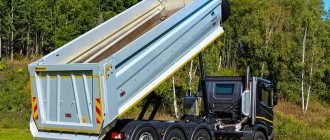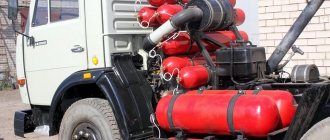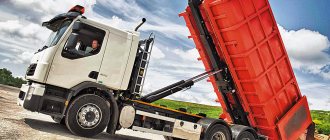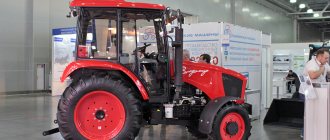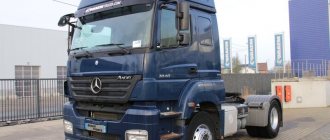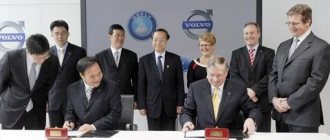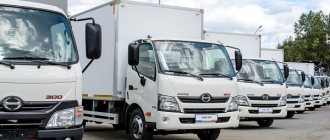Trunk silence
In front of me are 4x2 and 6x4 mainline tractors, a garbage truck, and a hook loader.
First of all, I climb into the R410 tractor with a 13-liter engine. I start the engine and am amazed at the silence: no vibrations, no background noise so characteristic of diesel engines. The gas engine is incredibly quiet, and the situation does not change when driving - only the slight howl of the wind in the mirrors and the rustling of the tires.
In addition to gas engines, Scania showed another new product for Russia - the G410 dump truck with an 8x4/4 wheel arrangement - with a rear bogie on three axles.
In addition to gas engines, Scania showed another new product for Russia - the G410 dump truck with an 8x4/4 wheel arrangement - with a rear bogie on three axles.
The traction is good: the tractor calmly pulls a large semi-trailer up a six percent climb. The engine really drives no worse than a diesel engine.
You won’t get agility from the 9-liter OC9 “five”, and this is not necessary. They put it on easier equipment. I chose the most colorful one - a bright blue P340 garbage truck. This is almost the only Scania that did not have a retarder. Therefore, on the descents of the Dmitrovsky Automotive Test Site, we had to carefully work on the brakes so as not to burn them to hell. However, the “garbage” habitat is a city where a retarder is unlikely to be useful.
Operating the retarder couldn't be easier. The intensity of deceleration is regulated by a steering column switch, and the speed on a descent is controlled by a switch on the steering wheel hub.
Operating the retarder couldn't be easier. The intensity of deceleration is regulated by a steering column switch, and the speed on a descent is controlled by a switch on the steering wheel hub.
Profitable carriers: methane-powered trucks
In the West, it’s hard to surprise anyone with a methane-powered truck. Where carriers are forced to count every euro cent, such cars are not uncommon, but not here. However, the situation is changing for the better
Mikhail Ozherelev
In Russia, where there are about 49 million cars, only 111 thousand units consume natural gas motor fuel. HMT accounts for 2.6% of the motor fuel market: propane-butane (2.1%) and CNG (0.5%). However, it is believed that CNG (aka methane) is better as an energy resource than propane-butane, which is still more common on the market. Methane is non-toxic, less explosive (since it is lighter than air and quickly evaporates when leaked), more environmentally friendly, and the natural gas supplied through the pipeline cannot be diluted or added impurities. It is also important that methane is cheaper: the average price in the country is 12.3 rubles. per cubic meter, while propane-butane costs approximately 16 rubles. per liter, while the consumption of the latter is 20% higher.
About two years have passed since the adoption of the government decree on the development of the gas motor fuel market in Russia, and during this time certain progress has been made in expanding the relevant infrastructure: construction of automobile gas filling compressor stations (CNG filling stations) is underway in the regions, and land plots are being allocated. Automakers were even more active. The domestic auto industry, meeting the requirements of the time, is increasing the serial production of gas versions of commercial vehicles, and importers also have corresponding proposals. It is noteworthy that, along with public transport and road and municipal equipment, the segment of heavy long-haul trucks using natural gas is growing. However, this is not surprising; just estimate the operating costs of long-distance road transport.
ALL SERIAL
The largest program for the development and production of gas-powered vehicles is being implemented by KamAZ. Today, the Kama auto giant is the only Russian automaker that has developed its own gas engine (now the Yaroslavl Avtodiesel is following a similar path). In 2014, KamAZ produced and sold about 1,000 gas vehicles, and this year the company plans to increase this figure. The gas version of the truck is about 20% more expensive than the standard one, but the production gas truck comes with a full factory warranty.
Volvo FH13 with gas equipment from the English company Clean Air Power
In the segment of long-haul tractors, the company offers three production models at once. The KamAZ-65116-30 truck tractor with a 6x4 wheel arrangement is designed to work as part of road trains with semi-trailers with a total weight of 38,500 kg (load on the fifth wheel coupling 15 tons), performing technological transportation of long cargo, construction materials, food liquids between enterprises located in large cities. The vehicle is equipped with an 11.7-liter KamAZ 820.62.260 gas engine (260 hp, Euro-4) and a 10-speed manual transmission (mod. 154). The vehicle's fuel system includes 13 composite cylinders with a capacity of 80 liters each: 9 cylinders are located vertically behind the cabin, 4 are located horizontally on the left side of the frame. The total volume of the cylinders is 1040 liters and holds 208 m3 of compressed natural gas at a pressure of 200 atm.
Scania P340 LA 4x2 HNA CNG truck tractor is available in Russia
The KamAZ-65116-32(6x4) truck tractor is designed to operate in conjunction with semi-trailers with a total weight of 38,800 kg. It is distinguished by a more powerful KamAZ-820.62.300 gas engine (300 hp, Euro-4), which is paired with a 9-speed ZF 9S1310TO gearbox.
Of particular interest is the KamAZ-65116 CNG/LNG tractor, which is capable of operating on both compressed (CNG) and liquefied natural gas (LNG). Cylinders with compressed methane are located vertically behind the cabin, and on the frame there is a cryotank for liquefied gas. The methane in the cryotank is at a temperature of –168 o C. The volume of the tank is 450 liters, or 240 m3 of gas, which is enough to cover a distance of up to 600 km. The total mileage using two tanks of the car reaches 1050 km. The use of liquefied natural gas is due to the fact that it is twice as efficient in storage volume as compressed gas. By the way, the idea is not new. Let us recall the small-scale modification of the medium-tonnage ZIL-138P with three cryogenic cylinders for operation on liquefied natural gas and gasoline.
DEMAND WILL COME
European importers are also assessing the prospects for the Russian market. Iveco is ready to offer carriers a new modification of the Stralis truck, equipped with a Euro-6 gas power unit. Iveco Stralis Natural Power is available in three versions: 2- and 3-axle chassis and 2-axle tractor unit. The assembly of the new product is carried out at the same facilities as the diesel version of the model - at a plant in Madrid. The machine is equipped with a Cursor 8 engine with a power range of 270–330 hp. With. The engine is paired with a 16-speed ZF manual transmission or a 6-speed Allison automatic transmission. The capacity of the machine's gas cylinders ranges from 400 to 1300 liters.
EcoGas is a new fuel brand developed by Gazprom Gas Engine Fuel
Note that Iveco is one of the market leaders in commercial models equipped with gas engines. The manufacturer's product line includes light, medium, and heavy trucks and buses running on CNG. At the moment, Iveco has already sold 12 thousand similar modifications, of which 2000 cars in 2014.
These eco-friendly Scania trucks are used to transport food at a major fast food chain
There is also good news for Scandinavian truck manufacturers. At the beginning of 2015, Scania certified three models of heavy methane trucks in Russia. The Scania P260 6x2/4 and Scania P340 6x2/4 trucks are refrigerated vans with a three-axle chassis, which are equipped with gas engines OS 09 G101 and OC 09 G 102 (Euro 6, 280 and 340 hp, respectively). The gas engine is converted from a diesel engine and operates on the Otto cycle. This is a 9-liter, 5-cylinder in-line engine with a turbine and intercooler. It is distinguished by multipoint injection, individual ignition coils and an intake throttle valve. The service interval for changing oil, spark plugs and filters is 45,000 km. The 8 steel cylinders on board with a total capacity of 824 liters provide a range of up to 490 km.
Iveco Stralis CNG version with Cursor 8 natural Power gas engine
In addition, Scania offers the Scania P340 LA 4x2 HNA CNG truck tractor in Russia. The vehicle with a 340-horsepower gas engine has a dead weight of 7800 kg and a fifth-wheel load of 10.5 tons. Scania P340 gas trucks have a lot of useful equipment that makes the driver’s work easier and reduces the owner’s costs. For example, the GA 766R (Allison MD 3200) 6-speed automatic transmission with two driving programs makes the truck much easier to drive and saves fuel. The company claims that these machines differ from analogues available on the Russian market by having the lowest impact on the environment.
A special feature of the KamAZ-65116 CNG/LNG truck tractor is the presence of a cryotank for liquefied methane
Another interesting model of an environmentally friendly Scandinavian-made tractor is in trial operation in Russia. We are talking about the new Volvo FH13 truck tractor, the engine of which operates on gas-diesel technology. The composition of the fuel mixture in a 13-liter 460-horsepower engine is proportional: approximately 75% methane and 25% diesel fuel (used as a pilot dose), but the ratio may vary depending on the type of transportation and method of operation of the vehicle.
Thus, manufacturers of methane-powered rolling stock are helping carriers today to take advantage of government support aimed at stimulating demand for gas-powered vehicles. They also make it possible to create a fleet of economical and high-quality vehicles with a high residual value on the secondary market.
DENIS KORNIENKO, MEMBER OF THE BOARD, DEPUTY GENERAL DIRECTOR FOR COMMERCIAL ISSUES, GAZPROM GAZEMOTOR FUEL LLC
Today, in the structure of motor fuel, the share of gasoline is 50%, the share of diesel fuel is approximately 47%, another 2.1% is propane-butane and only 0.5% is CNG. At the same time, about 111 thousand vehicles are operated in the country using gas engine fuel, which is only 0.2% of the entire Russian fleet. This is quite a bit, and our target is 5% for the replacement of traditional motor fuel with methane, in numerical terms - about 10 billion m3 annually.
The main task is to sell natural gas at gas stations. The consumer needs equipment that will run on this fuel. Therefore, we actively work with car manufacturers - we suggest which models the consumer requires, what the specifics of these cars are. Our partners are 26 Russian and foreign automakers, with whom we exchange information, conduct joint promotions, and organize test drives.
Today we see that automobile equipment running on natural gas is produced by both Russian and foreign enterprises, i.e. Almost full production of this equipment has been established. For example, any truck or bus produced by KamAZ can be ordered in a gas version.
Another important issue is the development of the gas station network. There are currently 268 operating automobile gas filling compressor stations (CNG filling stations) in Russia. Of course, this is not enough. For example, in Germany there are about 950 CNG filling stations, although its territory cannot be compared with ours. The increase in the number of CNG filling stations is achieved in two ways. The first way is to build our own filling network. Second, we work with private investors under a franchising program, as well as under a program for the construction of gas filling facilities by private investors with their subsequent acquisition by our company. We have identified 10 priority regions with the highest volumes of road traffic flows, among them: Moscow, St. Petersburg, Stavropol, Krasnodar Territory, the Urals and Volga regions. The gas filling network will develop most actively in these regions.
Within the framework of cooperation agreements concluded with the constituent entities of the Russian Federation, the optimal location of gas filling infrastructure facilities and their technical characteristics are determined, measures are being developed for regional programs to improve energy efficiency, and planning for the purchase of gas cylinder transport is being carried out. Thus, the process of building a gas filling network is synchronized with the transfer of municipal vehicle fleets to natural gas.
Reinhard Fleger © Photo: Skoda
Fred Kapler © Photo: Skoda
Reinhard Fleger has been appointed as the new member of the board of directors of Skoda Auto , responsible for sales and marketing. Fleger, 51, a member of the board of directors of Volkswagen de Mexico responsible for sales and finance, will take up a seat on the board of directors of Škoda Auto on June 1, 2009.
In addition, 50-year-old Fred Kappler , current member of the Škoda Auto board of directors responsible for sales and marketing, will be responsible for sales of VW Group worldwide. Rodolphe Bürgi, 59, who previously held this position, is retiring.
Reinhard Fleger graduated with a degree in economics and in 1992 headed the controlling department of the VW Group; in 1995 – sales management department at VW Group and VW Passenger Cars (since 2000). Since 2002, Fleger has been CFO and member of the Board of Directors of Gedas. From 2005 to present – CFO, member of the Board of Directors of Volkswagen de Mexico (since 2007 – also responsible for sales).
The editors recommend:
Why do piston rings stick and how to prevent it?
A traffic police officer searched my car: did he have the right to do so?
Russians may be left without foreign cars: Western automakers have stopped supplying cars to our country
A ship that was transporting cars to Russia was detained in France
Half of the car factories in Russia have closed
News Media2
